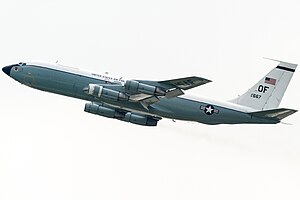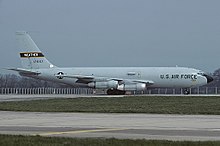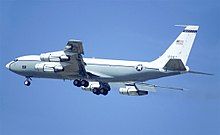
The OC-135B Open Skies is a United States Air Force observation aircraft that supports the Treaty on Open Skies. The aircraft, a modified WC-135B, flies unarmed observation flights over participating parties of the treaty. Three OC-135B aircraft were modified by the Aeronautical Systems Center's 4950th Test Wing at Wright-Patterson Air Force Base in Ohio but only two were ever used. The first operationally-capable OC-135B was assigned to the 24th Reconnaissance Squadron at Offutt AFB in October 1993. It is now fitted with a basic set of navigational and sensor equipment, and was placed in inviolate storage at the Aerospace Maintenance and Regeneration Center at Davis-Monthan Air Force Base near Tucson, Arizona in 1997. Two fully operational OC-135B aircraft were delivered in 1996 with the full complement of treaty-allowed sensors, which includes an infrared line scanner, synthetic aperture radar and video scanning sensors.

The Boeing RC-135 is a family of large reconnaissance aircraft built by Boeing and modified by a number of companies, including General Dynamics, Lockheed, LTV, E-Systems, and L3 Technologies, and used by the United States Air Force and Royal Air Force to support theater and national level intelligence consumers with near real-time on-scene collection, analysis and dissemination capabilities.

Offutt Air Force Base is a U.S. Air Force base south of Omaha, adjacent to Bellevue in Sarpy County, Nebraska. It is the headquarters of the U.S. Strategic Command (USSTRATCOM), the 557th Weather Wing, and the 55th Wing of the Air Combat Command (ACC), the latter serving as the host unit.

The Sixteenth Air Force (Air Forces Cyber) (16 AF) is a United States Air Force (USAF) organization responsible for information warfare, which encompasses intelligence gathering and analysis, surveillance, reconnaissance, cyber warfare and electronic warfare operations. Its headquarters is at Joint Base San Antonio-Lackland in Texas.

The Boeing C-135 Stratolifter is a transport aircraft derived from the prototype Boeing 367-80 jet airliner in the early 1950s. It has a narrower fuselage and is shorter than the 707. Boeing gave the aircraft the internal designation of Model 717. Since the first one was built in August 1956, the C-135 and its variants have been a fixture of the United States Air Force.
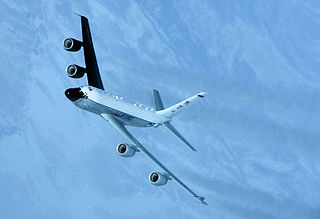
The 55th Wing is a United States Air Force unit assigned to Air Combat Command. The wing is primarily stationed at Offutt Air Force Base, Nebraska, but maintains one of its groups and associated squadrons at Davis-Monthan Air Force Base, Arizona, as a geographically separated unit.

The 95th Reconnaissance Squadron is a squadron of the United States Air Force. It is assigned to the 55th Operations Group, Air Combat Command, stationed at Offutt Air Force Base, Nebraska. The squadron is equipped with several variants of the Boeing C-135 aircraft equipped for reconnaissance missions.

The 55th Operations Group is a component of the 55th Wing, assigned to the United States Air Force Air Combat Command. The group is stationed at Offut Air Force Base, Nebraska.

The United States Air Force's 6th Air Refueling Wing is the host wing for MacDill Air Force Base, Florida. It is part of Air Mobility Command's (AMC) Eighteenth Air Force. The wing's 6th Operations Group is a successor organization of the 3d Observation Group, one of the seven original combat air groups formed by the United States Army Air Service shortly after the end of World War I.

The Boeing EC-135 is a retired family of command and control aircraft derived from the Boeing C-135 Stratolifter. During the Cold War, the EC-135 was best known for being modified to perform the Looking Glass mission where one EC-135 was always airborne 24 hours a day to serve as flying command post for the Strategic Air Command in the event of nuclear war. Various other EC-135 aircraft sat on airborne and ground alert throughout the Cold War, with the last EC-135C being retired in 1998. The EC-135N variant served as the tracking aircraft for the Apollo program.

The Boeing NC-135 and NKC-135 are special versions of the Boeing C-135 Stratolifter and Boeing KC-135 Stratotanker modified to operate on several different programs.

Looking Glass is the historic code name for an airborne command and control center operated by the United States. In more recent years it has been more officially referred to as the ABNCP. It provides command and control of U.S. nuclear forces in the event that ground-based command centers have been destroyed or otherwise rendered inoperable. In such an event, the general officer aboard the Looking Glass serves as the Airborne Emergency Action Officer (AEAO) and by law assumes the authority of the National Command Authority and could command execution of nuclear attacks. The AEAO is supported by a battle staff of approximately 20 people, with another dozen responsible for the operation of the aircraft systems. The name Looking Glass, which is another name for a mirror, was chosen for the Airborne Command Post because the mission operates in parallel with the underground command post at Offutt Air Force Base.

The 186th Air Refueling Wing is a unit of the Mississippi Air National Guard stationed at Meridian Regional Airport, Mississippi. The 153d Air Refueling Squadron, assigned to the Wing's 186th Operations Group, was established on 18 August 1939 as the 153d Observation Squadron, one of the 29 National Guard observation squadrons formed before World War II.

The 38th Reconnaissance Squadron is a United States Air Force unit. It is a part of the 55th Wing at Offutt Air Force Base, Nebraska. It operates the Boeing RC-135 aircraft conducting reconnaissance missions.

The 55th Air Refueling Squadron is an inactive United States Air Force unit. It formerly operated both the combat crew training school and central flight instructor course for Boeing KC-135 Stratotanker at Altus Air Force Base, Oklahoma.

The 22d Expeditionary Air Refueling Squadron is a provisional United States Air Force unit, assigned to Air Mobility Command. It is engaged in combat operations as part of the Global War on Terrorism in Afghanistan. Its current status and location are undetermined. The squadron's permanent designation is the 22d Air Refueling Squadron.

The Airborne Launch Control System (ALCS) provides a survivable launch capability for the United States Air Force's LGM-30G Minuteman III intercontinental ballistic missile (ICBM) force. The ALCS is operated by airborne missileers from Air Force Global Strike Command's (AFGSC) 625th Strategic Operations Squadron (STOS) and United States Strategic Command (USSTRATCOM). The system is located on board the United States Navy's E-6B Mercury, which serves as USSTRATCOM's "Looking Glass" Airborne Command Post (ABNCP). The ALCS crew is integrated into the ABNCP battle staff and is on alert around the clock.
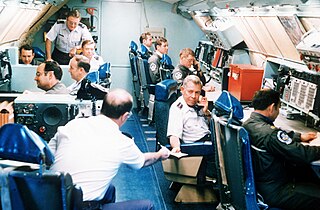
The United States Air Force's 2d Airborne Command and Control Squadron was an airborne command and control unit located at Offutt Air Force Base, Nebraska. The squadron was an integral part of the United States' Post Attack Command and Control System, performing the Operation Looking Glass mission with the Boeing EC-135 aircraft.
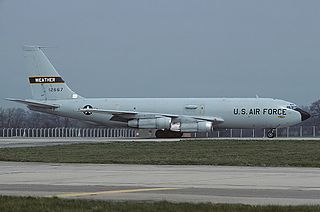
The 55th Space Weather Squadron is an inactive United States Air Force unit. It was last assigned to the 50th Operations Group at Schriever Air Force Base, Colorado, where it was inactivated on 16 July 2002.

The 45th Reconnaissance Squadron is a United States Air Force unit. It is assigned to the 55th Operations Group and stationed at Offutt Air Force Base, Nebraska. It is one of the most decorated squadrons of the active duty United States Air Force with a combat record in three wars, and a peacetime record of vital contributions to worldwide reconnaissance, treaty monitoring, and pilot proficiency training.
